The term “Earth’s orbit” refers to the specific path that the planet takes as it moves through space. As we know, the Earth’s orbit is centered around the Sun. Currently, scientists have determined that the average distance between our planet and the Sun is approximately 149.6 million kilometers.
Discovery of Earth’s Orbit
In ancient times, the prevailing belief was in the geocentric model of the universe, which posited that the Earth was the center of everything, with all celestial bodies moving around it. However, this view was later replaced by the heliocentric model, which placed the Sun at the center and depicted the movement of cosmic bodies revolving around it.
Furthermore, heliocentrism also described the motion of the planets in the solar system, revealing that their orbits were not circular as previously believed. Instead, observations showed that their orbits took on the shape of spheres. This new understanding led scientists to use spherical shapes to define orbital paths.
It is important to mention that numerous brilliant scientists dedicated their efforts to understanding the nature of the Universe. Notable figures such as Ptolemy, Plato, and Aristotle have all contributed to the model of the Universe. Furthermore, Nicolaus Copernicus made a significant impact on this subject. He also played a crucial role in advancing the theory of heliocentrism, which in turn led to the exploration of Earth’s orbit.
What is the Earth’s orbit
As we now understand, the Earth revolves around the Sun following a specific path. What exactly does this path look like?
Johannes Kepler discovered that the planets travel along an elliptical path, and this includes our own Earth. Previously, astronomers believed that this path was a perfect circle.
Now, an elliptical orbit is essentially a stretched out circle with a certain level of eccentricity. The eccentricity determines how closely the shape resembles a circle, ranging from 0 to 1. A value of 0 represents a perfect circle with the Sun at the center, while a value of 1 represents a highly elongated shape.
For our planet, this eccentricity is 0.0167. In other words, the Earth’s orbit closely resembles a slightly elongated circle.
Furthermore, a crucial aspect of orbital characterization involves the distance between the celestial body and its primary luminary. To address this, specific points are defined on the orbit of the astronomical object:
- apocenter – the farthest point from the luminary;
- pericenter – the closest point to the central luminary.
On the flip side, the Earth system experiences aphelion (the point of farthest distance) and perihelion (the point of closest distance). In the former scenario, the distance to the Sun measures 152 million km, while in the latter, it amounts to 147 million km. Nonetheless, the average distance is generally considered to be 149.6 million km.
In reality, any slight alteration in the Earth’s circular orbit can have a profound impact on the planet’s existence. This is because the orbital position plays a crucial role in maintaining a specific temperature on Earth.
Incidentally, the average distance from the Earth to the Sun (150 million kilometers) is commonly referred to as one astronomical unit. This serves as a unit of measurement for distances in space.
It has now been determined that the Earth orbits around the Sun at a velocity of 108,000 kilometers per hour. This means that it takes 365 days for the planet to complete one full revolution. To be more precise, it actually takes 365.242199 days. As a result, every four years we add an extra day to our calendar.
As mentioned earlier, the tilt of the Earth’s axis has a significant impact on our orbit. This is what causes the changing seasons. In other words, it leads to the occurrence of solstices and equinoxes.
The plane of orbit
It is fascinating that all celestial bodies move along flat paths in space. These paths, known as orbits, are confined to a single plane. For instance, the Earth’s orbit lies on a plane called the ecliptic, which is also where the orbits of all the planets in the Solar System are found.
The Earth’s rotation axis is tilted at an angle of 23° with respect to the ecliptic. This tilt is the reason why different hemispheres of the Earth experience varying levels of heat, resulting in distinct weather patterns throughout the seasons.
Living on Earth can be costly, but it comes with the perk of a free annual journey around the Sun.
Ashley Diamond
The ongoing study and exploration of Earth is still in progress at present. This is likely due to the fact that our planet is in a constant state of movement. However, the movement cannot remain consistent at all times.
Interestingly, according to Kepler’s laws, celestial bodies have the ability to revolve around the main star for their entire existence. However, there can be deviations in the trajectory of their motion. As a result, scientists have proposed various scenarios for when and how planets can deviate from their usual orbit.
Currently, computer modeling is utilized for making such predictions. The outcome yields multiple potential futures for our solar system. Ultimately, only time will reveal what will transpire.

There are over 3,000 satellites that circle the Earth, serving various purposes for mankind. These satellites play a crucial role in providing advanced communication systems, navigation assistance, and collecting precise data on global issues such as pollution levels and the likelihood of natural disasters. These efforts are aimed at achieving the United Nations’ goals of sustainable development.
The team at MaxPolyakov.Space provides insights into the concept of Earth’s orbit and how its exploration has contributed to the betterment of humanity.
During nighttime, the naked eye can only perceive a limited portion of the vast universe. The farthest object visible to the human eye is a faint spot known as the Andromeda Nebula, which is a galaxy located approximately 2.5 million light-years away from Earth.
Much closer to us, just a few hundred kilometers above the Earth’s surface, lies the Earth’s orbit.
Thanks to the advancements in space exploration, we now have access to satellite television, wireless Internet, accurate weather forecasts, and GPS – a satellite navigation system that can pinpoint a person’s location with a smartphone anywhere on Earth with a high level of accuracy.
Science and technology continue to make significant strides in exploring the space around our planet. However, it is unfortunate that many people still underestimate the importance of this field. In the United States, for instance, only 5% of the population considers themselves well-informed about space exploration, while just over a third of respondents in the European Union can explain the role of an aerospace agency.
What many people fail to realize is that they rely on space technology more often than they think, even for the most mundane tasks.
Take, for instance, the fact that individuals, on average, dedicate over two hours each day utilizing a smartphone, which includes relying on satellite assistance for navigation. Just a decade ago, it was quite common to find oneself disoriented in an unfamiliar city without the aid of such technology integrated into smartphones.
These functionalities are made possible through the utilization of artificial satellites, with a staggering count of over three thousand in existence. The United States boasts the largest constellation of satellites, with a total of 1.8 thousand devices under its ownership.
What does it mean to be in a near-Earth orbit?
An orbit is the path that a celestial body takes as it revolves around another celestial body that has a much greater mass. For instance, the Earth orbits around the Sun and the Moon orbits around the Earth.
A near-Earth orbit refers to the specific orbit around our planet. It is a hypothetical sphere that extends from the Earth’s surface up to an altitude of 2,000 kilometers above sea level. This type of orbit is commonly used by spacecrafts that orbit the Earth and it can range in altitude from 160 kilometers (with an orbital period of approximately 88 minutes) to 2,000 kilometers (about 127 minutes).

The concept of orbit as we know it today originated from the observations made by the Polish astronomer Nicolaus Copernicus in the 16th century. Copernicus recognized that the Earth, along with other planets like Venus and Saturn, revolves around the Sun. This groundbreaking idea sparked further scientific exploration and investigation into the nature of planetary motion. Scientists meticulously calculated the rotation periods of various planets and even identified satellites orbiting around them. These findings gradually replaced the ancient belief that the Earth stood at the center of the universe.
In the 17th century, Isaac Newton, an English scientist, made a significant contribution to our understanding of orbit by introducing the concept of gravity. Newton’s discovery of the force that governs the movement of matter helped explain why celestial bodies remain connected and form stable systems, where a star occupies the central position and planets revolve around it.
If the scientists of that era were solely focused on understanding nature, then in the 19th century, researchers aimed to transcend the known world. It was during this time that the renowned science fiction author Jules Verne first provided a scientific description of a journey from Earth to the Moon. Concurrently, scientists began proposing theories on rocket propulsion to explore outer space, and following World War II, the United States, the Soviet Union, and other nations around the globe started actively developing this technology, particularly for military objectives.
Take, for instance, the Soviet Sputnik 1, the pioneering artificial Earth satellite launched in 1957, which was successfully placed into orbit by an intercontinental ballistic missile. This groundbreaking device had immense scientific importance as it enabled the study of the upper atmosphere, a feat that was previously unattainable. Subsequent satellites also made significant contributions to scientific advancements. For instance, the American Explorer 1, launched in 1958, played a crucial role in the discovery of the radiation belt.
Organization of the Earth’s Orbit
The Earth’s orbit is a diverse phenomenon that is classified by altitude in the field of astronomy.
Located at a distance of 35 thousand kilometers is the geostationary orbit, where satellites rotate in sync with the Earth, remaining at the same longitude.
This particular orbit plays a crucial role in weather monitoring, as satellites positioned here have the ability to continuously observe the same area of the planet from a high vantage point.
How does it function? When a user visits a website to check the weather forecast, they can view satellite images of their specific location. These images are transmitted from the geostationary orbit, where dedicated satellites are positioned. These satellites update and transmit information about clouds, water vapor, and wind every few minutes, enabling accurate weather forecasts for the user’s locality.
The Low Earth Orbit, situated at an altitude ranging from 160 to 2,000 kilometers, stands as the nearest space region to the Earth’s surface. This orbit serves as a home to numerous space stations and a majority of satellites, totaling almost 2,000.
Surviving in this orbit without a life support system, like the one employed by astronauts during spacewalks, is impossible for humans.
Contrary to popular belief, the space within the low-Earth orbit is not devoid of substances. Atmospheric gases manage to penetrate this region, albeit to a limited extent, exerting a slight influence on orbital objects. This effect can be likened to the air flow acting upon a bullet discharged from a rifle, albeit significantly weaker. The average temperature in this space hovers around 10 degrees Celsius. Given its close proximity to the Earth’s surface, it is not surprising that certain conditions bear a resemblance to those found on the planet.
Within this orbit, satellites operate to serve humanity’s needs. Some of these satellites have been functioning for up to 15 years.
The space debris that is non-functional is known as space junk. Space agencies from all over the world are actively involved in removing these objects as they pose a threat to operational satellites. They have the potential to cause damage, which would require costly repairs, or they can interfere with the accuracy of satellite data.
What advantages does orbit provide for humanity?
Space exploration is closely linked to human economic development, as there are already numerous man-made objects orbiting the Earth. NASA states that space exploration not only brings technological and cultural advantages, but also offers fresh insights into finding solutions for existing problems on Earth. Many essential aspects of modern life, such as improved solar panels that convert solar energy into electricity, various medical technologies, ultralight metal alloys, water purification systems, advanced electronics, and more, have been made possible thanks to civilization’s venture into space.

Let’s outline the key advancements of entering into orbit:
- Satellite television. Satellites transmit signals directly to households where they are received by antennas. Additionally, space devices enable live broadcasts with exceptional image and audio quality.
- Telephone communications. In-flight telephones, satellite phones in remote areas lacking cell phone towers, or in regions affected by disasters.
- Internet. SpaceX has initiated the launch of satellites for the Starlink global wireless Internet project. By the end of the year, the company plans to launch a total of 1.5 thousand units.
- Meteorology. Satellites play a crucial role in assessing global weather conditions and providing accurate forecasts. They also enable scientists to monitor and track dangerous natural disasters like volcanic eruptions and forest fires. The satellites operated by the U.S. National Oceanic and Atmospheric Administration (NOAA) have been instrumental in conducting over 48,000 rescue operations since 1982.
- Land use. Satellites have the ability to detect underground water and mineral reserves, track the movement of nutrients and harmful substances from land to water bodies, and monitor algae growth in the oceans. They also provide important surveillance of large-scale infrastructure such as gas and oil pipelines. Max Polyakov’s EOSDA company is actively involved in the development of advanced satellite technologies for land use monitoring.
- Science. Thanks to the deployment of astronomical equipment in space, it has become feasible to investigate the vastness of the universe without the constraints of our planet. The Hubble Space Telescope has the capability to capture much more than instruments based on Earth, as they are hindered by the atmosphere.
The utilization of Earth’s orbit also presents fresh prospects for commerce – for instance, NASA envisions that commercial initiatives could eventually establish a self-reliant, thriving orbital economy, with private enterprises taking the forefront.
NSR forecasts predict that in the next decade, over 12,000 satellites will be launched into orbit, generating a staggering income of more than $130 billion from a single launch. According to Morgan Stanley, a leading financial institution, the total market value of the orbital economy will reach one trillion dollars by 2040. Furthermore, it is projected that by this time, at least half of the satellites will be dedicated to providing high-speed internet, which will be significantly more affordable, costing less than 1% of its current price.
An orbit is the trajectory that a celestial body follows as it revolves around the Sun. This concept was initially demonstrated by Nicolaus Copernicus, who disproved the belief that our planet was stationary in space.
Discovery of Earth’s Orbit
In ancient times, the prevailing belief among scholars like Ptolemy, Aristotle, and their followers was that the universe was geocentric, with the Earth at its center and all celestial bodies revolving around it. However, this view was challenged by the ancient Greek scientist Aristarchus of Samosia. In the 3rd century BC, while observing a lunar eclipse, Aristarchus concluded that the Moon was not an independent light source, but rather reflected sunlight. He also deduced that the Moon was much smaller than the Sun in diameter. These observations led Aristarchus to question why a large celestial body like the Sun would revolve around a smaller Earth.
The geocentric theory was ultimately disproven in 1534 by the Polish astronomer Nicolaus Copernicus, who proposed the heliocentric model. Copernicus demonstrated that it was not possible for the Sun to revolve around the Earth, providing further evidence for the existence of Earth’s orbit around the Sun.
Distance between the Earth and the Sun
The distance from our planet to the Sun is determined by its position in space. This distance can be measured in different ways:
- At perihelion (the closest point to the Sun), the distance is approximately 147.1 million kilometers;
- At aphelion (the farthest position from the Sun, also known as apogee), the distance is about 152.1 million kilometers.
For rough calculations, the average distance (orbital semi-major axis) is considered to be around 149.6 million kilometers. This value is commonly used as the standard unit of distance in space, known as 1 astronomical unit (a.u.). Using this unit makes it easier to measure distances in outer space compared to calculating absolute values.
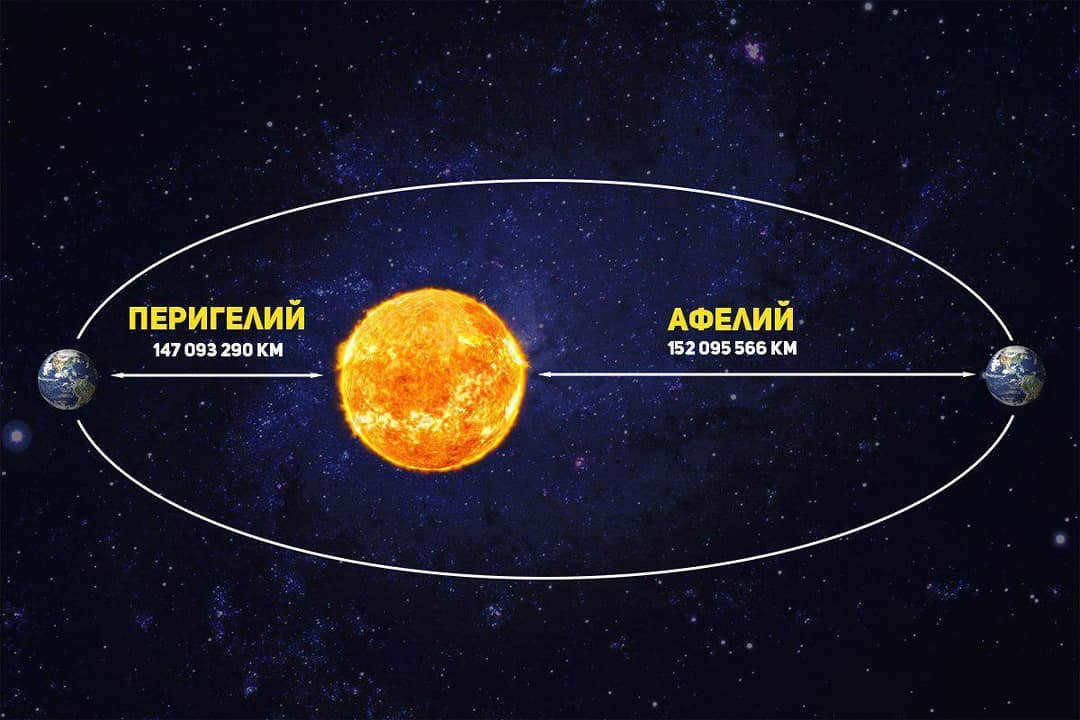

The average distance from the Earth to the Sun is approximately 150 million kilometers, which is equivalent to 0.000004848 parsecs. This measurement system was established during the Middle Ages, when all linear distances were expressed relative to the distance between the Earth and the Sun. It wasn’t until 1672 that the European scientist J. Cassini made the first estimation of the Earth’s orbital radius, determining it to be 140 million kilometers. This value was later refined by Soviet astronomers in 1961, who calculated the orbital radius to be 149.5993 million kilometers with a margin of error of +/- 2000 km.
The distance to the Sun does not affect the change of seasons, which is solely determined by the axial tilt of the Earth.
The Earth’s closest distance to the Sun, known as perihelion, occurs between January 2 and January 5 annually. Interestingly, despite the increased solar heat during this period, the northern hemisphere experiences winter at this time. On the other hand, the Earth’s farthest distance from the Sun, known as aphelion, occurs between July 3 and July 7. Despite the reduced light and heat from the Sun during this time, summer persists in all regions north of the equator.
The elliptical shape of Earth’s orbit
While most planets in our solar system have elliptical trajectories, Earth’s orbit appears more circular, although it is not a perfect circle. Instead, our planet moves around the sun in a slightly elongated ellipse.
One important characteristic of orbits is their eccentricity, which measures their level of compression. Eccentricity values range from 0 (indicating a perfect circle) to 1 (representing the narrowest possible ellipse, almost resembling a straight line). Earth’s eccentricity is relatively small, measuring only 0.017. This places it as the third most circular orbit among planetary-type objects in the Solar System, following Venus (with an eccentricity of 0.007) and Neptune (E=0.011).
A small adjustment in the orbital radius of our planet is crucial for the creation and advancement of life on Earth, as it helps maintain a stable average temperature. In contrast, Mercury has an eccentricity of 0.2, resulting in drastic temperature fluctuations between day and night. The orbit of Mercury is the most elongated among all the planets in our solar system.
The length of Earth’s orbit is approximately 930-940 million kilometers.
The Earth’s speed during its orbital motion is approximately 30 km/s. According to the principles of physics, any object will follow an elliptical path, moving at different speeds. At perihelion, the Earth accelerates to 30.2 km/s, while at aphelion, its speed decreases to 29.2 km/s.
It takes the Earth 365.24 days to complete one revolution around the Sun. For simplicity, this period is rounded to 365 days, but every 4 years, the Earth’s calendar is adjusted by adding an extra day.
Plane of Orbit
The points of every orbit are always situated within the same plane. In the case of Earth, this celestial “surface” is known as the ecliptic, with all the other planets in the system moving in planes that are similar to ours.
The central star also undergoes rotation on its axis, following the same direction as all the neighboring celestial objects. This provides indirect evidence that the star, along with all the other celestial bodies in the system, originated from a single gas and dust proto-cloud. However, there is one phenomenon that remains unexplained: the Sun rotates with a significant deviation from the ecliptic. It is possible that there are large undiscovered planets in close proximity to us, whose gravitational influence has a significant impact on our star.
The ecliptic plays a role in determining the tilt of the axis of celestial bodies. In our case, the tilt is 23°, which causes the uneven heating of the northern and southern hemispheres during different parts of the Earth’s orbit and the changing of seasons.
The variation of the orbit from its ideal shape
Isaac Kepler formulated several laws that describe the principles of celestial body motion, and there was no reason for the scientists of the 17th century to doubt them. However, as measurements became more precise, deviations from Kepler’s laws began to be discovered. The German astronomer based his model on two simplifications:
- The weight of any planet was considered negligible compared to the weight of the Sun;
- Only the gravitational interaction between the luminary and the planet was considered, without taking into account the influence of nearby celestial bodies.
Diagram depicting the evolution of the solar system’s barycenter over time. Attribution: Wikimedia Commons.
In present times, scientists consider an additional crucial element when determining orbital properties. They acknowledge that not only does the planet revolve around the star, but the “celestial body – star” combination also undergoes its own rotation around the barycenter – an imaginary point in space representing the center of mass. Given the significance of solar dimensions, the barycenter of our system resides within the Sun and experiences slight shifts in position.
Currently, the distance between our planet and the Sun increases by 15 cm every year, and over the course of 67 thousand years, the semi-major axis will have shifted by a kilometer – a relatively insignificant change in the vastness of space and time. However, this distance will not constantly increase; every 100 thousand years, it will alternate between increasing and decreasing.
This cyclic pattern has been observed on Earth for millions of years and has been responsible for various global cataclysms, such as ice ages.
In addition to the changing distance to the Sun, the eccentricity of our orbit is also in a constant state of flux. Throughout history, its value has varied from 0.05 to 0.005, different from its present value.
What is the stability of Earth’s orbit?
According to Kepler’s laws, the planets in our solar system and other celestial objects are capable of indefinitely orbiting their respective stars. However, there are instances where these celestial bodies may deviate from their orbits and drift into outer space or be drawn towards the Sun, resulting in a collision.
While it is impossible to predict analytically, computer modeling also fails to provide an accurate depiction of the future fate of our solar system. The orbit of Mercury appears to be the most unstable, as it may either crash into the Sun or veer dangerously close to it, potentially leading to a collision with Venus or Earth. The outlook for Earth is more promising, as it is expected to remain in its orbit for billions of years to come.
The orbit refers to the trajectory followed by a celestial body in space. It is a term that can be used to describe the path of any object, but it is commonly used to refer to the path of motion of bodies that interact with each other. This includes the orbits of planets, satellites, and stars within systems.
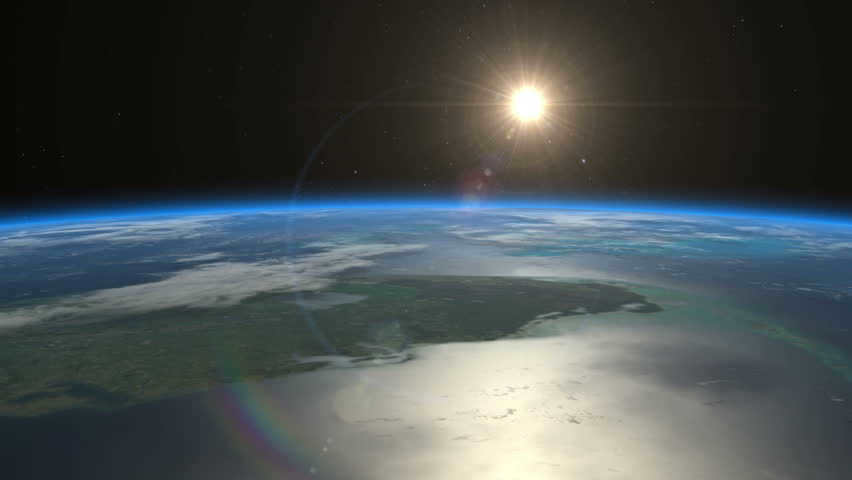

Categories of orbits
There are two categories of orbits: relative and absolute orbits.
An absolute orbit is the trajectory of a celestial body within a predefined reference system, which is universally recognized. The Universe itself serves as a prime example of such a system.
What sets the two apart?
Understanding the distinction between absolute and relative orbits is crucial when it comes to calculating trajectories based on Newton’s laws. While Newton’s laws are only applicable for calculating absolute orbits, we are more accustomed to observing the motion in relative terms.
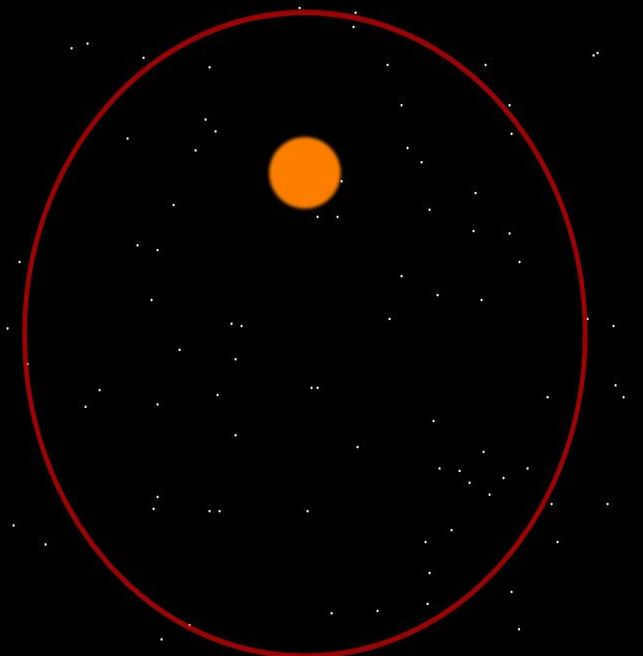
The Sun’s Movement
The Sun travels through space along the ecliptic, following a path similar to Earth’s orbit. As the cosmic sphere is crisscrossed by the orbit, it creates a vast circular plane known as the ecliptic. The equator and ecliptic planes intersect at a specific angle, which determines the locations of the vernal and autumnal equinoxes. Twice a year, the Sun passes through these points as it transitions from the northern hemisphere to the southern hemisphere and vice versa.
Earth’s path around the Sun
The Sun is located at one end of the elliptical orbit that the Earth follows. The distance from the Sun to Earth changes over the course of the year, ranging from 147 million kilometers to 152 million kilometers. The total distance of the Earth’s orbit is approximately 930 million kilometers. Our planet moves in a westerly to easterly direction at a speed of around 30 km/s. It takes 365 days, 6 hours, 9 minutes, and 9 seconds for Earth to complete one full orbit, which is known as a sidereal year.
Additionally, there is the concept of a tropical year, which measures the time between consecutive occurrences of the Sun passing through the vernal equinox point. This time interval is equal to 365 days, 5 hours, 48 minutes, and 46 seconds.
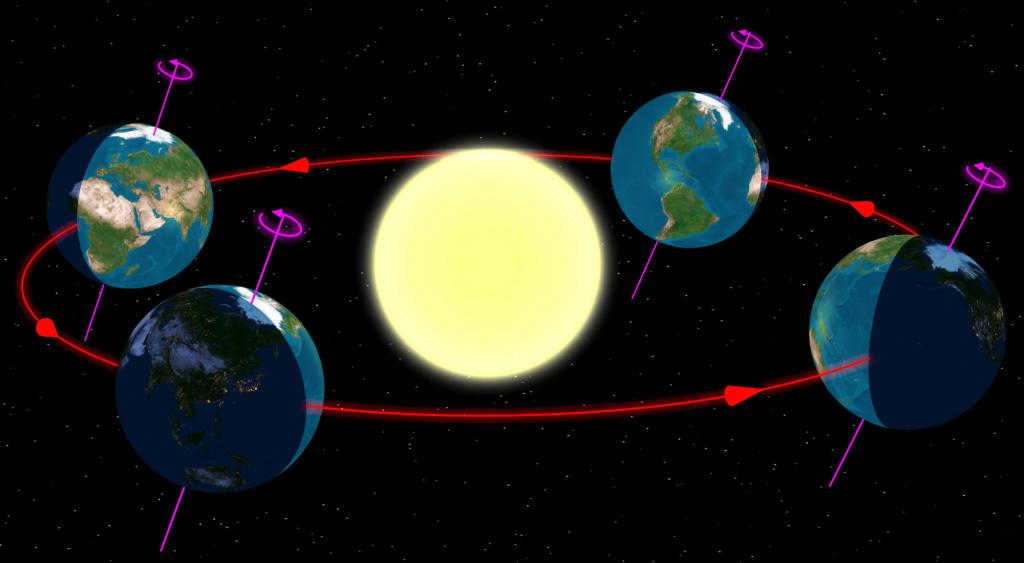
Timetable
Individuals utilize the Gregorian timetable to measure time, adjusted to the length of the tropical year with a slight difference. Consequently, even in fifty thousand years, winter will happen in the winter months and summer in the summer months.
At present, the Earth’s pivot is tilted at an edge of 66.5 degrees to the orbital plane. The planet moves during 365 days parallel to itself in cosmic space. The result of the Earth’s movement around the sun is the change of seasons and different lengths of day and night.
Because of the Earth’s axial tilt relative to its orbital plane, the planet’s position in space remains constant. This also impacts the varying angles at which the sun’s rays strike the Earth’s surface.
During the summer solstice, the Earth’s axis points towards the north, facing our star. Conversely, during the winter solstice, it points towards the Sun from the southern region.
Elliptical orbit
After considering the length of day and night and analyzing the Sun’s positions at different points, scientists have reached the conclusion that our planet doesn’t follow a circular path, but instead moves in an elliptical orbit. This discovery was initially described by Kepler, who also determined that both Mars and Earth experience periodic acceleration and deceleration. Through thorough observations and calculations, he concluded that the planet’s movement is not in a circular orbit, but in an elliptical one.
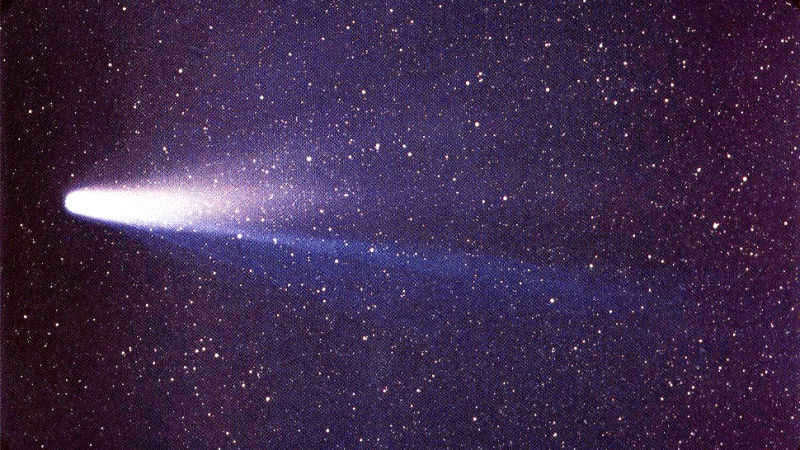
The movement of celestial objects in the vastness of space
The path of the Sun around the center of the Milky Way
The Sun’s journey through the Universe takes place along a galactic orbit. In relation to the surrounding stars, our star travels at a velocity of 19 km/s towards the constellation of Hercules. It is believed that it takes the Sun approximately 230 million years to complete a full circle around the center of the Milky Way. The orbital path of a star is intricate, as it is constantly influenced by the gravitational pull of massive cosmic bodies, other stars, and interstellar gas.
The Earth’s orbit is the trajectory along which a celestial body revolves around the Sun. This concept was first established by Nicolaus Copernicus. Prior to his groundbreaking discovery, it was widely believed that our planet remained stationary in outer space.


The Discovery of Earth’s Orbit
In ancient times, the prevailing belief was that the Earth was at the center of the universe, with all celestial bodies orbiting around it. This geocentric model was widely accepted by prominent scholars like Ptolemy and Aristotle. However, one Greek scientist named Aristarchus of Samosia challenged this idea in the 3rd century BC. While observing a lunar eclipse, he noticed that the Moon does not emit its own light but rather reflects sunlight. He also realized that the Moon is much smaller in diameter compared to the Sun. These observations led Aristarchus to question why the Sun, a much larger celestial body, would revolve around the relatively tiny Earth.
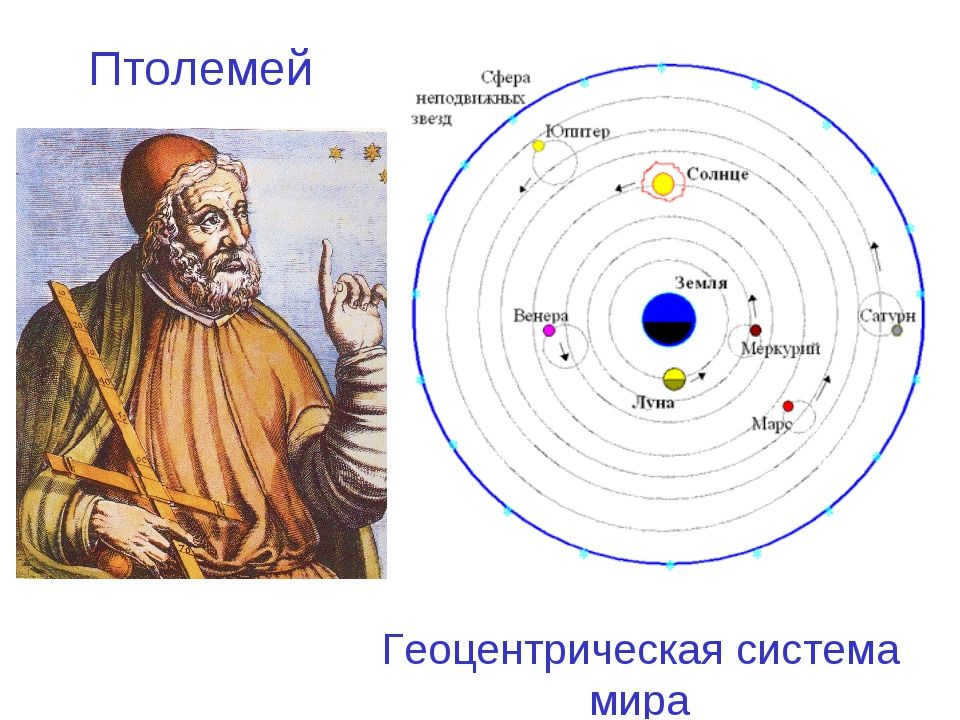
The heliocentric doctrine, which states that the Earth revolves around the Sun, was established in 1534 by the Polish astronomer N. Copernicus, effectively debunking the geocentric theory. Copernicus provided evidence to support his theory, proving that the Sun cannot revolve around the Earth.
In further support of the heliocentric model, the German scientist I. Kepler discovered in the 16th century that the shape of our planet’s orbit is elliptical. Through careful observation of the Earth and Mars, Kepler noticed that the planets experience periods of deceleration and acceleration, a phenomenon that would be impossible if the orbit were perfectly circular.
How Far is the Earth from the Sun?
The distance between the Sun and the Earth is determined by the position of our planet in space. The distance can be calculated as follows:
- At perihelion (the point closest to the Sun), the distance is 147.1 million kilometers;
- At aphelion (the farthest point from the Sun, also known as apogee), the distance is 152.1 million kilometers.
For approximate calculations, the average distance of 149.6 million kilometers (orbital semi-major axis) is commonly used. This value is considered the standard measure of distances in space and is known as 1 astronomical unit (a.u.). Using this unit makes it easier to determine the length of objects in outer space without having to calculate absolute values.

In the Middle Ages, a measure was established to express linear distances based on the distance between the Earth and the Sun. However, it did not have a specific numerical value initially. It was not until 1672 that the European scientist J. Cassini made the first estimation of the Earth’s orbital radius, which was determined to be 140 million kilometers. This value was later refined by Soviet astronomers in 1961. They calculated the Earth’s orbital radius to be 149.5993 million km with an error margin of +/- 2000 km.
The distance to the Sun does not affect the change of seasons, which is solely determined by the tilt of the Earth’s axis.
The perihelion point of our planet occurs annually between January 2 and January 5. Despite the fact that the solar heat on the planet’s surface decreases during this period, the northern hemisphere experiences winter at this time. On the other hand, the Earth reaches aphelion between July 3 and July 7, during which the minimum amount of light and heat from the sun does not hinder the continuation of summer in all regions north of the equator.
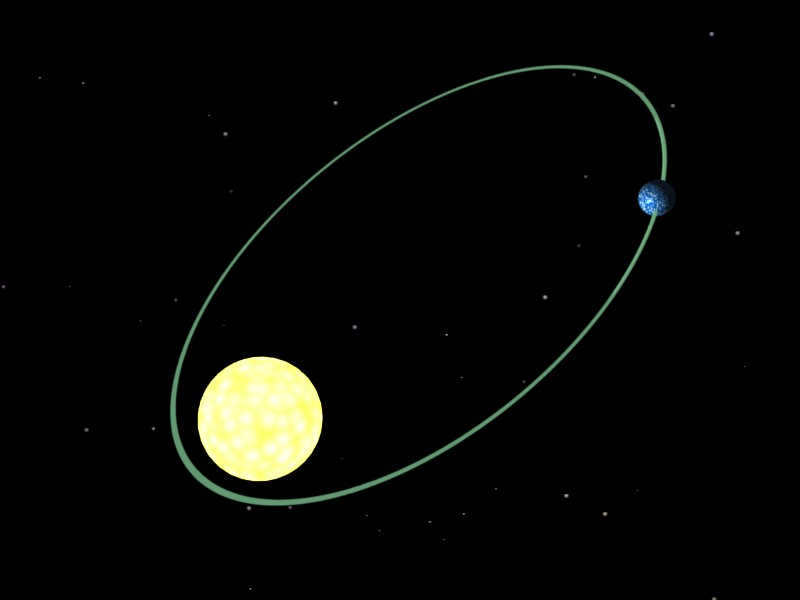

Earth’s Orbital Trajectory Shape
The shape of the Earth’s orbit appears more circular compared to other planets in our solar system, but it is not a perfect circle. Instead, it follows a slightly elongated ellipse as we revolve around the Sun.
The key characteristic of orbits is their eccentricity, represented by the coefficient E, which measures their compression. The eccentricity value ranges from 0 (indicating a perfect circle) to 1 (representing the narrowest possible ellipse, nearly a straight line). The Earth has a small eccentricity value of only 0.017. This places it as the third lowest among planetary objects in the Solar System, following Venus with an eccentricity of 0.007 and Neptune with E=0.011.
The estimated length of the Earth’s orbit is around 930-940 million kilometers.
The velocity of our planet’s movement
The Earth’s orbital movement occurs at an average velocity of approximately 30 km/s. As per the laws of physics, any object will travel along an uneven elliptical orbit: faster at perihelion (where our planet accelerates to 30.2 km/s) and slower at aphelion (Earth’s velocity is 29.2 km/s).
It takes the planet 365.24 days to complete one revolution around the Sun. For the sake of convenience in calculations, this period is rounded off to 365 days, but every 4 years the Earth’s calendar is adjusted by introducing an additional day.
Orbit plane
The points of any orbit always lie in the same plane. The ecliptic is the cosmic “surface” that Earth is on, while all the other planets in the system move in planes that are similar to ours.
The central luminary also rotates on its axis in the same direction as all the neighboring planetary objects. This indirectly suggests that it and all the other bodies in the system were formed from a single gas-dust proto-cloud. However, there is still one phenomenon that has not been explained: the Sun rotates with a significant deviation from the ecliptic. It is possible that there are undiscovered large planets nearby that have a gravitational influence on our star, causing this effect.
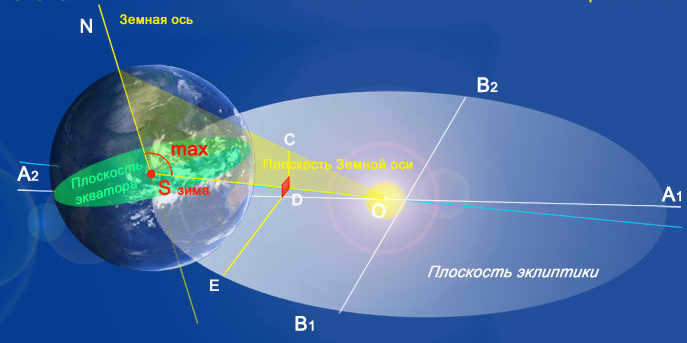
The inclination of the axis of a celestial body can be estimated by considering the ecliptic. In the case of Earth, this inclination is 23°, which is responsible for the uneven heating of the southern and northern hemispheres throughout the year as the Earth moves through different parts of its orbit, resulting in the change of seasons.
The deviation of the orbit from its ideal shape
Several laws were derived by I. Kepler to describe the principles of motion of celestial bodies, and there was no reason for scientists in the XVII century to doubt them. However, as measurements became more accurate, deviations from the Keplerian doctrine started to be discovered. The model built by the German astronomer was based on two simplifications:
- It was assumed that the weight of any planet was negligibly small compared to the weight of the Sun;
- Only the mutual gravitational influence of the Sun and the planet was taken into account, and the influence of neighboring celestial bodies was ignored.
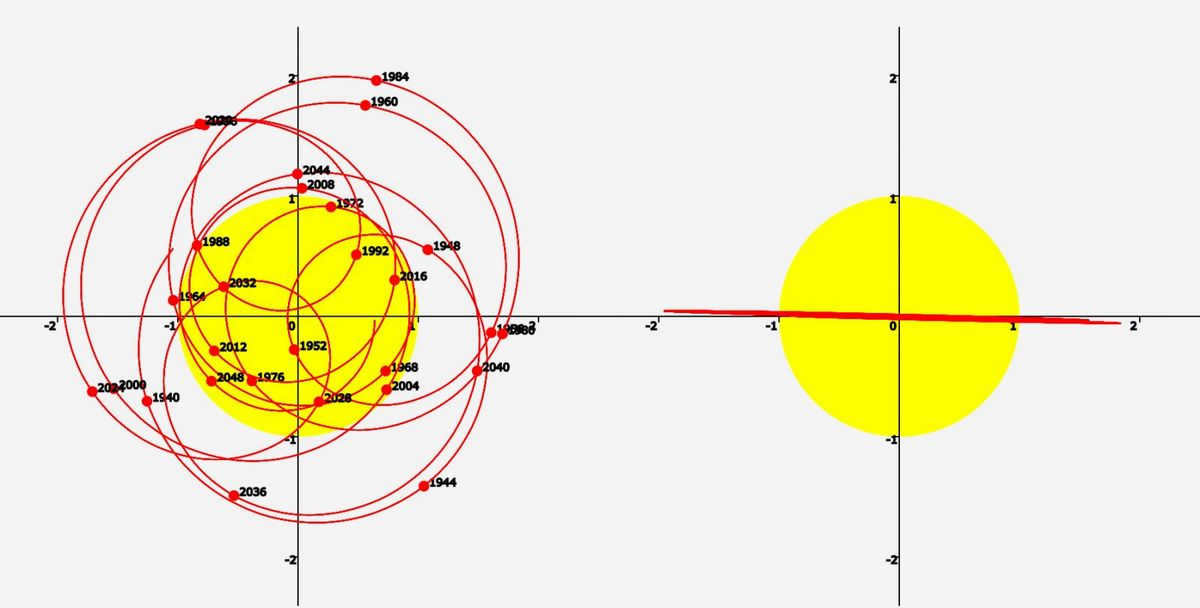
In the present day, scientists consider another crucial factor in the calculation of orbital characteristics. They take into account that it is not only the planet that orbits around the star, but also the “celestial body – star” bundle which undergoes its own rotation around the barycenter, an imaginary point in space representing the center of mass. Given the significance of solar dimensions, the barycenter of our system lies within the Sun and experiences slight changes in its position.
This recurring cycle has been witnessed on the planet for countless millennia, resulting in a multitude of worldwide cataclysms, including ice ages.
In addition to the Sun’s proximity, the ellipticity of our orbit is in a perpetual state of flux. Throughout various years, its magnitude has varied from the present-day value, oscillating between 0.05 and 0.005.
How secure is the Earth’s orbit?
Based on Kepler’s laws, the planets in our solar system, as well as other local celestial objects, have the capability to indefinitely orbit around their respective stars. However, there are instances where celestial bodies may deviate from their orbits and venture into outer space or become attracted to the Sun and collide with it.
While it is not possible to make an analytical prediction, computer simulations do not provide a precise depiction of the future destiny of our solar system. Mercury appears to be the least stable, as it may either fall into the Sun or move away from it to the point of colliding with Venus or Earth. Fortunately, the prospects for Earth are more favorable, as it will remain in its orbit for billions of years to come.
In the 16th century, Nicolaus Copernicus sparked a true revolution by providing evidence that the Sun is positioned at the center of the solar system, with all other objects orbiting around it in a heliocentric system. But what about the Earth’s circular orbit?
Characteristics of Earth’s Orbit
The Earth revolves around the Sun in an orbit with a speed of 108,000 km/h, taking 365.242199 solar days to complete one orbit. This is why we need to add an extra day every 4 years.
The distance between the Earth and the Sun varies as it orbits. The planet comes closest to the Sun (perihelion) at a distance of 147,098,074 kilometers. The average distance is 149.6 million kilometers. The farthest point from the Sun (aphelion) is 152,097,701 km.
If you live in the northern hemisphere, you might have noticed that the temperature doesn’t solely depend on the distance from the Sun because it also relies on the Earth’s axial tilt.
Earth’s non-circular path
Contrary to popular belief, the Earth does not follow a perfectly circular orbit. Instead, our planet travels along an elongated ellipse. This phenomenon was initially explained by the famous astronomer Johannes Kepler. You can examine the Earth’s orbital movement in the provided diagram.
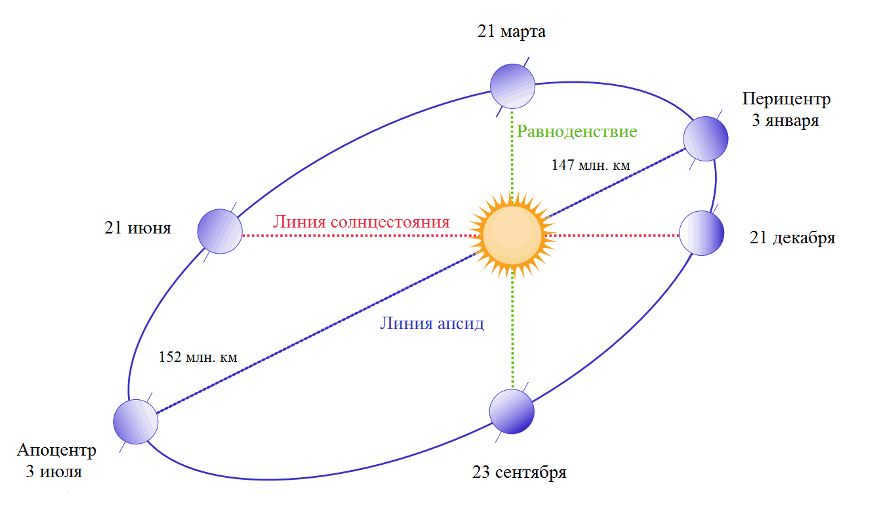
The scientist conducted measurements on the paths of Earth and Mars and made a fascinating discovery – they undergo periodic variations in velocity. This phenomenon correlates with the distance from the star, which is determined by the orbital velocity (not a perfectly circular orbit).
To describe the characteristics of elliptical paths, scientists utilize the concept of eccentricity, which ranges from 0 to 1. A value close to 0 indicates an orbit that is nearly circular. In the case of Earth, the eccentricity is 0.02, implying a nearly circular orbit.
The Earth’s axis tilt is a significant factor in the creation of our four seasons. The existence of these seasons is a direct result of the Earth’s axis rotating at a 23.4° angle, which gives rise to both solstices and equinoxes.
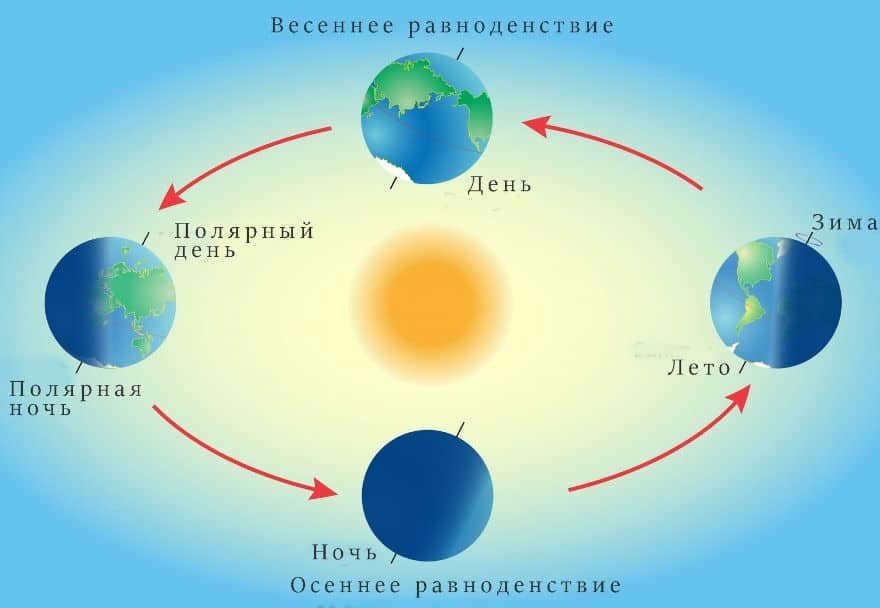

The Earth’s axis remains fixed, causing solar radiation to be distributed differently
This means that when the northern hemisphere moves away from the Sun, it enters winter, while the southern hemisphere experiences summer. After 6 months, they switch places. The winter solstice falls on December 21, the summer solstice occurs on June 21, the spring equinox occurs around March 20, and the fall equinox occurs on September 23.
What are Lagrange points in space? This is another interesting point. There are 5 points along our orbital path where the combined gravitational force between the Earth and the Sun provides a centripetal force.
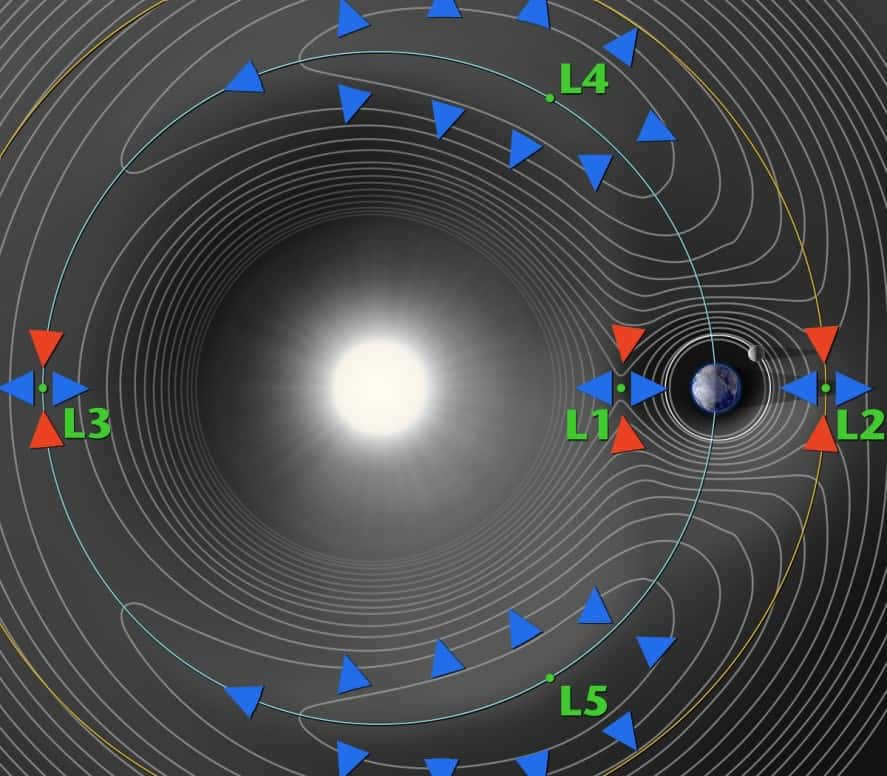
The Earth-Sun Lagrangian points are designated as L1 through L5. L1, L2, and L3 lie along a straight line connecting Earth to the Sun. These points are not stable, meaning that satellites placed there will eventually move away.
L4 and L5, on the other hand, form the corners of two triangles, with the Sun and Earth at the base. These points are stable and are ideal locations for probes and telescopes.
Studying the orbits of not only our own planet, but also other celestial bodies in our solar system, is crucial. The distance from a star often plays a significant role in the potential for life to exist on a planet.
- How many satellites does Earth have?
- Is Earth spherical?
- What causes Earth to be round?
- Are there any rings around the Earth?
- What is the size of the Earth?
- The Earth’s age;
- The mass of the Earth;
- The gravity of the Earth;
- What is the weight of the Earth?
- Comparison of the Earth’s weight;
- The Earth’s size;
- The diameter of the Earth;
- The circumference of the Earth;
- The density of the Earth;
- The Earth’s magnetic field;
- The reversal of the Earth’s magnetic field;
The position and motion of the Earth
- The Earth, Sun, and Moon;
- What causes the change in day and night?
- Milankovitch cycles;
- The solar day;
- How long does it take for sunlight to reach the Earth?
- The Earth’s rotation around the Sun;
- What is the Earth’s rotation?
- Why does the Earth rotate?
- What is the reason for the Earth’s tilt?
- What causes the Earth’s magnetic north pole to shift?
- How does the Earth’s orbit affect its tilt?
- What is the significance of the precession of the equinoxes?
- How does the distance from the Earth to the Sun impact its tilt?
- Which is the closest star to Earth?
- Which planet is closest to Earth?
- How long does a day last on Earth?
- What is the significance of the Winter Solstice?
- How long is the duration of the Earth’s year?
- What is the rotational speed of the Earth?
- What is the axis of rotation for the Earth?
- What is the degree of tilt of the Earth?
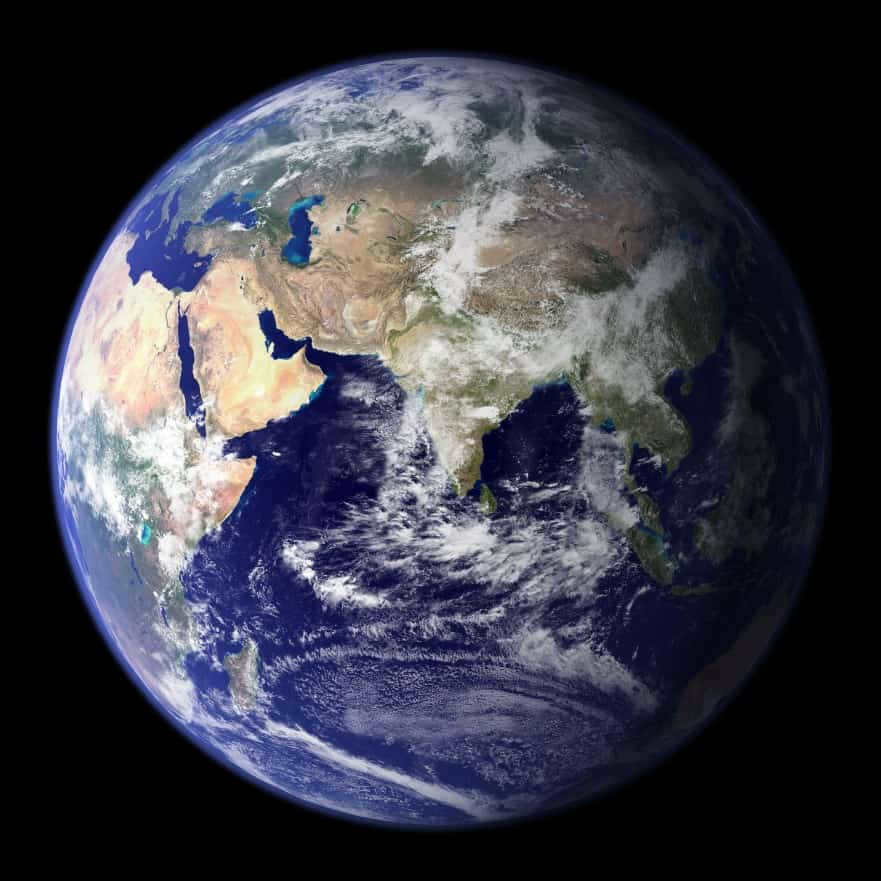
Undoubtedly, our planet holds a special place in our hearts. We cherish it not only for being our home, but also for its exceptional status within the solar system and the vast universe. As far as our knowledge goes, Earth is the only known habitat for life. Situated in the inner region of the system, it resides between Venus and Mars.

The Earth, known by various names such as the Blue Planet, Gaia, Peace, and Terra, has played different roles in the history of each nation. It is a planet teeming with diverse forms of life, but have you ever wondered how it became this way? Let’s explore some fascinating facts about our home.
Intriguing Trivia
- The Earth’s rotation on its axis is gradually slowing down, but this change is almost imperceptible to us earthlings, occurring at a rate of 17 milliseconds per 100 years. However, the speed of this slowing down is not consistent, leading to an increase in the length of the day. In about 140 million years, a day on Earth will last 25 hours.
- Ancient astronomers had the ability to observe celestial objects from the vantage point of our planet, leading them to believe that all objects in the sky were moving relative to us while we remained stationary. This led Copernicus to propose the heliocentric model, with the Sun at the center of everything. However, we now know that even this model does not accurately represent the true scale of the Universe.
- The Earth’s magnetic field is generated by the rapidly rotating nickel-iron core of our planet. This field plays a crucial role in protecting us from the solar wind’s influence.
- When considering percentages, the Moon is the largest satellite in our system. However, in terms of size, it is actually the fifth largest.
- Ancient scientists named all 7 planets after gods, and modern scientists have continued this tradition by naming Uranus and Neptune.
- Everything is determined by the composition and specific components of each planet. The core, made of metal, is denser than the crust. Earth has an average density of 5.52 grams per cm3.
Earth is ranked 5th in terms of size and mass, with a radius of 6371 km and a mass of 5.97 x 10 24 kg. It is the largest planet of terrestrial type, but smaller than gas and ice giants. However, Earth ranks first in the solar system in terms of density (5.514 g/cm 3 ).
Earth’s Physical Characteristics
The orbit of Earth has a slight eccentricity of 0.0167. It is 0.983 a.u. from the star at perihelion and 1.015 a.u. at aphelion.
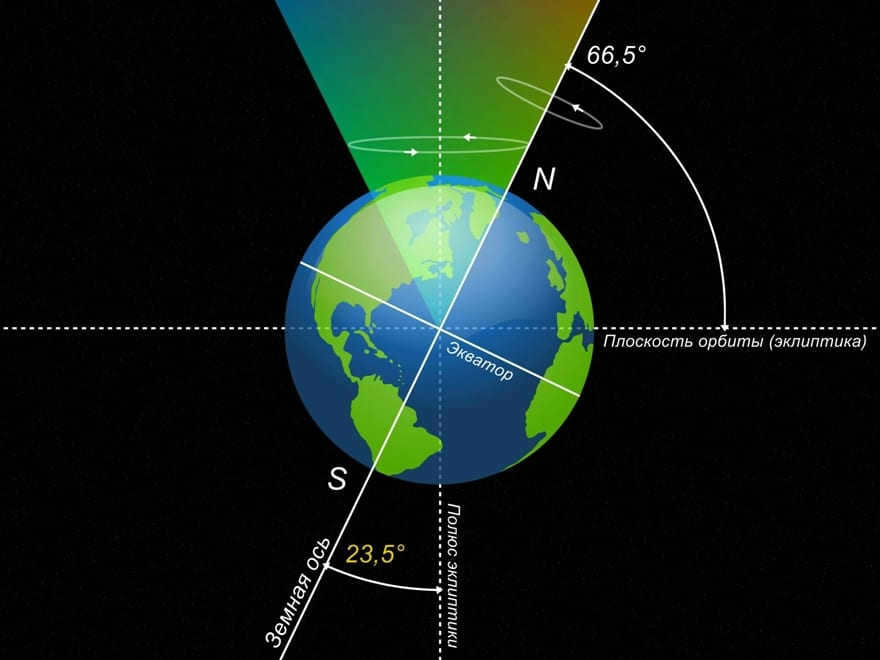

The axial tilt of the Earth and its relationship to the axis of rotation and orbital plane
It takes 365.24 days for the Earth to complete one orbit around the Sun. This is determined by the existence of leap years, where an extra day is added every four orbits. While we commonly think of a day as lasting 24 hours, in reality, it takes 23 hours, 56 minutes, and 4 seconds.
A skilled tarot reader will provide answers to the following questions:
What does the future hold for you? How will your relationships unfold? What is the best course of action to take?

By observing the axis rotation from the poles, it becomes evident that it rotates in a counterclockwise direction. The axis is inclined at an angle of 23.439281° relative to the perpendicular of the orbital plane. This inclination has a direct impact on the distribution of light and heat on the planet.
Earth’s orbit and rotation
| 147,098,290 km 0.98329134 a. e. |
| 152,098,232 km 1.01671388 a. e. |
| 149 598 261 km 1.00000261 a. e. |
If the Sun is positioned above the North Pole, it results in summer in the northern hemisphere and winter in the southern hemisphere. In certain areas above the Arctic Circle, the Sun remains below the horizon for a certain period, leading to a six-month period of darkness and winter.
The shape of planet Earth resembles a spheroid, with a flattened shape at the poles and a bulge at the equatorial line (measuring 43 km in diameter). This unique shape is a result of the planet’s rotation.
The Earth’s structure can be described in terms of its various layers, each with its own distinct chemical composition. What sets our planet apart from others is the clear division between the solid inner core (with a radius of 1220 km) and the liquid outer core (extending to 3400 km).
Following the core, we have the mantle and the crust. The mantle extends to a depth of 2890 km and is the densest layer. It consists of silicate rocks containing iron and magnesium. The crust can be further divided into the lithosphere, which comprises the tectonic plates, and the asthenosphere, which has a lower viscosity. A diagram can provide a visual representation of the Earth’s structure.
Visual representation of the Earth’s layers, including the inner and outer core, mantle, and crust.
The lithosphere is divided into solid tectonic plates, which are rigid blocks that have the ability to move in relation to each other. These plates have areas where they connect and areas where they break apart. It is the interaction between these plates that causes natural phenomena such as earthquakes, volcanic eruptions, the formation of mountains, and the creation of ocean trenches.
There are a total of 7 major tectonic plates on Earth, which include the Pacific Plate, North American Plate, Eurasian Plate, African Plate, Antarctic Plate, Indo-Australian Plate, and South American Plate.
One interesting fact about our planet is that approximately 70.8% of its surface is covered by water. The map below illustrates the distribution of tectonic plates on Earth.
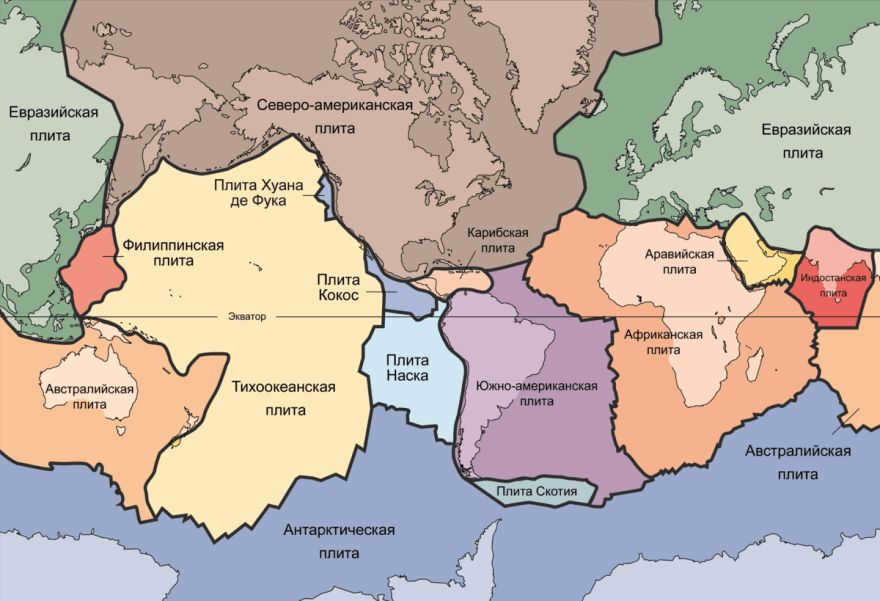

Earth’s tectonic plates
The Earth’s terrain varies greatly across its surface. The submerged areas resemble mountains and feature underwater volcanoes, oceanic trenches, canyons, plains, and even oceanic plateaus.
Throughout the planet’s history, its surface has undergone constant changes. The movement of tectonic plates and erosion play a significant role in these transformations. Additionally, other factors such as glacier movements, the formation of coral reefs, and meteorite impacts also contribute to these changes.
There are three types of continental crust: igneous rocks, sedimentary rocks, and metamorphic rocks. Igneous rocks are further classified into granite, andesite, and basalt. Sedimentary rocks make up 75% of the continental crust and are formed when sediment accumulates and becomes buried. Metamorphic rocks, on the other hand, are created through the metamorphosis of sedimentary rock.
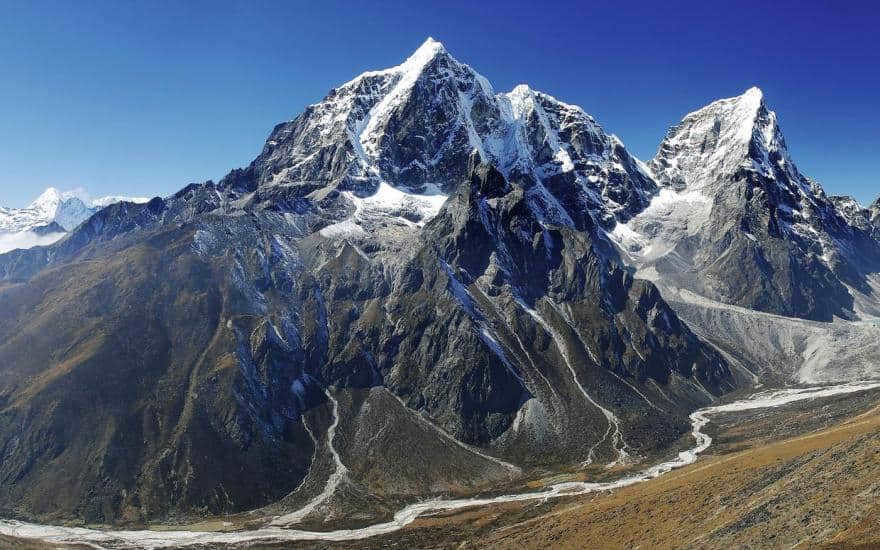
The surface elevation ranges from -418 m (at the Dead Sea) to 8848 m (Mt. Everest), making it the highest point on Earth. On average, the land stands at an elevation of 840 meters above sea level. The distribution of landmasses is also divided between hemispheres and continents.
A skilled tarot reader will provide answers to the following inquiries:
What lies ahead in your future? How will your relationships unfold? What is the best course of action to take?

The soil is located in the outer layer of the Earth. It acts as a boundary between the lithosphere, atmosphere, hydrosphere, and biosphere. About 40% of the Earth’s surface is dedicated to agricultural activities.
The Earth’s Atmosphere and Temperature
The Earth’s atmosphere is composed of five layers: the troposphere, stratosphere, mesosphere, thermosphere, and exosphere. As you ascend through these layers, the amount of air, pressure, and density decreases.
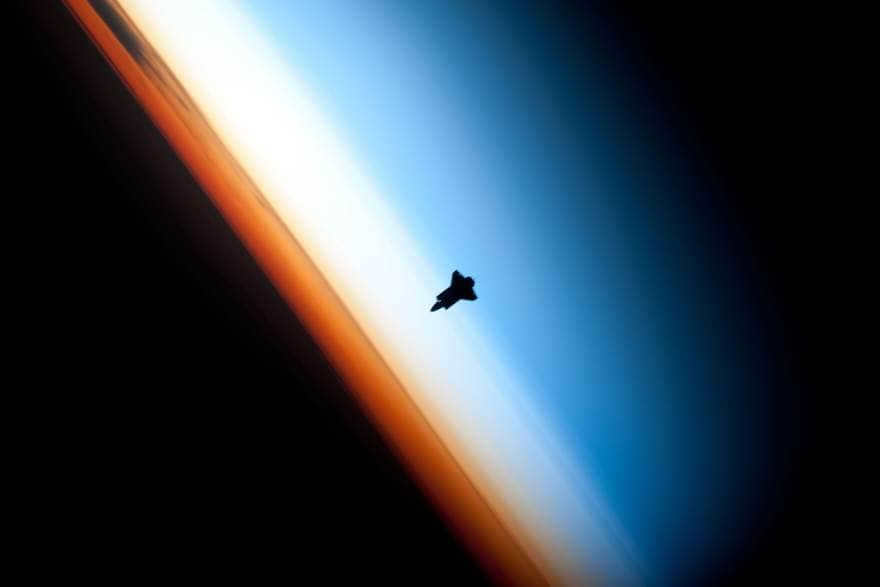

The photograph taken by the spacecraft Endeavor showcases the Earth’s atmosphere. The orange layer depicted in the photograph corresponds to the troposphere.
The troposphere, which is closest to the Earth’s surface (0-12 km), contains approximately 80% of the total mass of the atmosphere, with 50% of it concentrated within the first 5.6 km. This layer mainly consists of nitrogen (78%) and oxygen (21%), along with traces of water vapor, carbon dioxide, and other gaseous molecules.
Extending from 12 to 50 km, we encounter the stratosphere. It is separated from the troposphere by the tropopause, which is characterized by relatively warm air. This is also where the ozone layer is situated. As this layer absorbs ultraviolet light, the temperature increases. The figure illustrates the various atmospheric layers of the Earth.
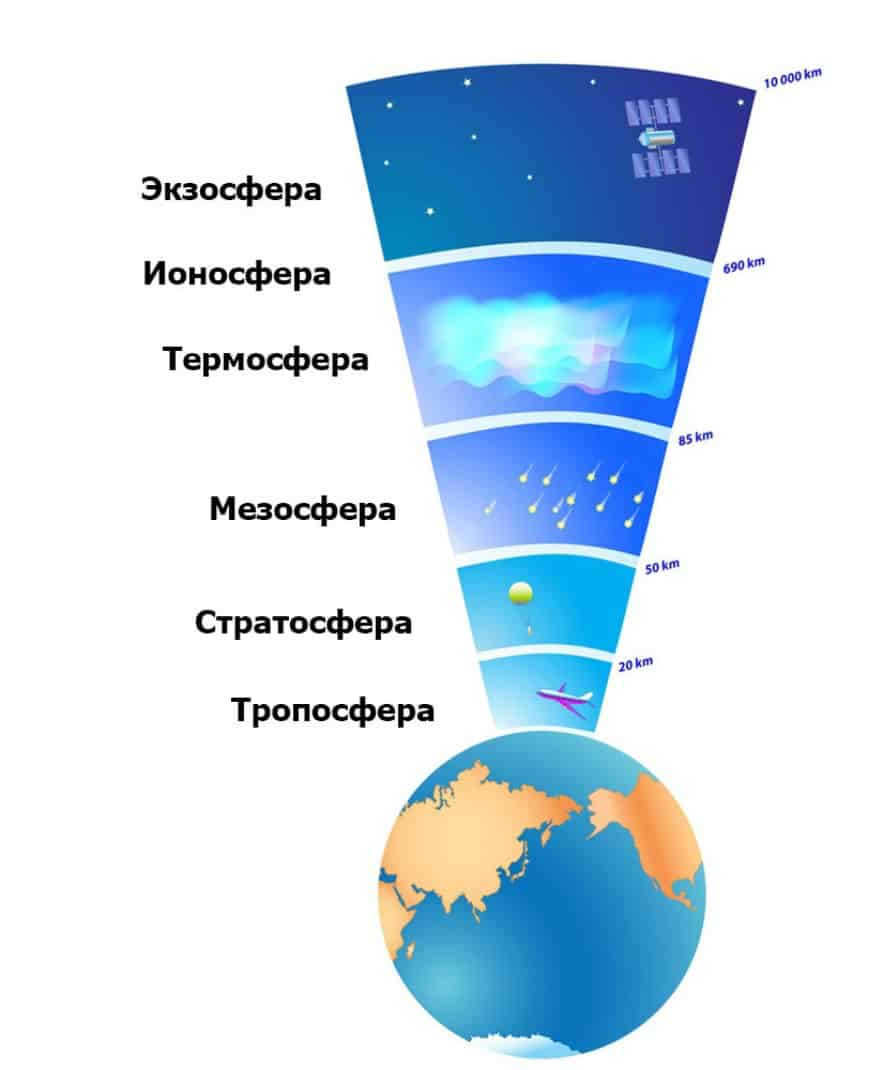

The atmospheric layer showcases the altitude at which the most prevalent auroras occur.
This layer remains stable and is devoid of turbulence, clouds, and other meteorological formations.
The mesosphere resides at an elevation of 50-80 kilometers. This region represents the coldest area, with temperatures dropping to -85°C. It spans from the mesopause to the thermopause, which extends from 80 km to 500-1000 km. From 80-550 km lies the ionosphere, where the temperature increases with altitude. The photograph of Earth captures the beauty of the aurora borealis in this particular region.
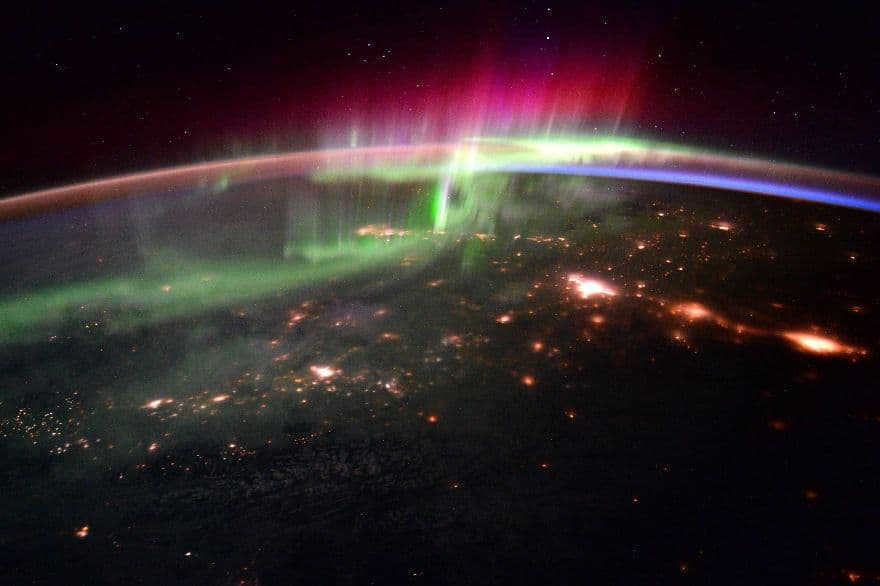
The photograph depicts the aurora borealis as seen from the International Space Station on July 25, 2010.
The region, where the aurora borealis occurs and the International Space Station is situated (at an altitude of 320-380 km), is characterized by the absence of clouds and water vapor.
The outermost layer is known as the exosphere, which serves as a transitional zone to outer space and lacks an atmosphere. It consists mainly of hydrogen, helium, and other molecules with low density. However, the layer does not behave like a typical gas due to the highly dispersed nature of its atoms, resulting in particles continuously escaping into space. This region is home to numerous satellites.
There are several factors that influence this measurement. The Earth undergoes a rotation on its axis every 24 hours, resulting in one side always experiencing nighttime and lower temperatures. Additionally, the Earth’s axis is tilted, causing the northern and southern hemispheres to alternate between tilting towards and away from the sun.
All of these factors contribute to the occurrence of seasons. Not every region on Earth experiences drastic changes in temperature. For instance, the amount of sunlight reaching the equator remains relatively consistent.
When calculating the average temperature, it comes out to be 14°C. However, the highest recorded temperature is 70.7°C in the Lut Desert, while the lowest temperature of -89.2°C was recorded at the Soviet Vostok station on the Antarctic Plateau in July 1983.
The Earth has a solitary natural satellite that has a significant impact on both the physical aspects of the planet, such as tides, as well as its history and culture. Specifically, the Moon stands as the lone celestial body that has been set foot upon by humans. This historic event took place on July 20, 1969, with Neil Armstrong being granted the honor of taking the first step. In total, a group of 13 astronauts have successfully landed on this celestial satellite.
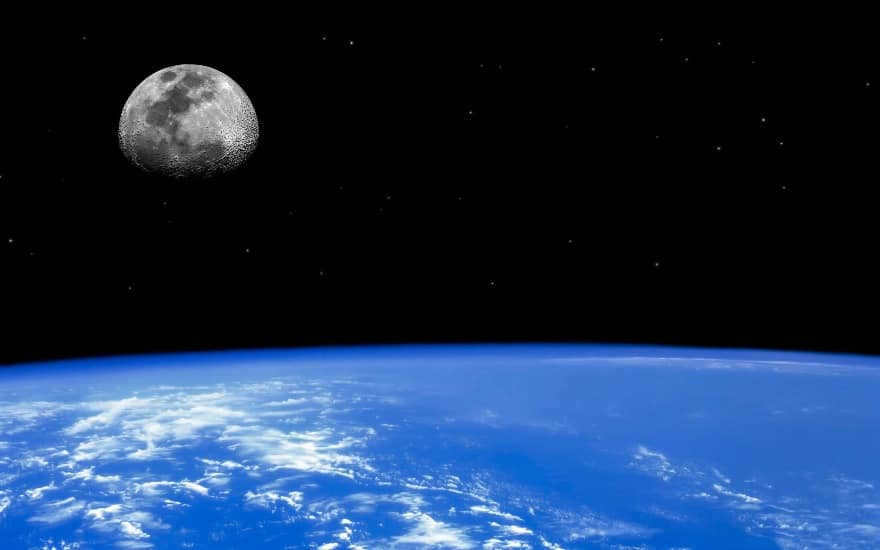

The Earth has only one satellite, which is the Moon.
The Moon came into existence approximately 4.5 billion years ago as a result of a collision between the Earth and a celestial body called Theia. Our satellite is quite remarkable, as it is one of the largest moons in the entire solar system and has the second highest density, surpassed only by Io. It is in a state of synchronous rotation with the Earth, meaning that one side of the Moon always faces our planet.
With a diameter of 3474.8 km (which is about a quarter of the Earth’s diameter) and a mass of 7.3477 x 10 22 kg, the Moon has an average density of 3.3464 g/cm 3 . Its gravitational force is only about 17% of the Earth’s gravity. The Moon has a significant impact on Earth’s tides and influences the behavior of various living organisms.
It is important to remember that lunar and solar eclipses occur. The lunar eclipse occurs when the Moon enters the Earth’s shadow, while the solar eclipse occurs when the Moon passes between us and the Sun. The atmosphere of the Moon is thin, resulting in extreme temperature fluctuations ranging from -153°C to 107°C.
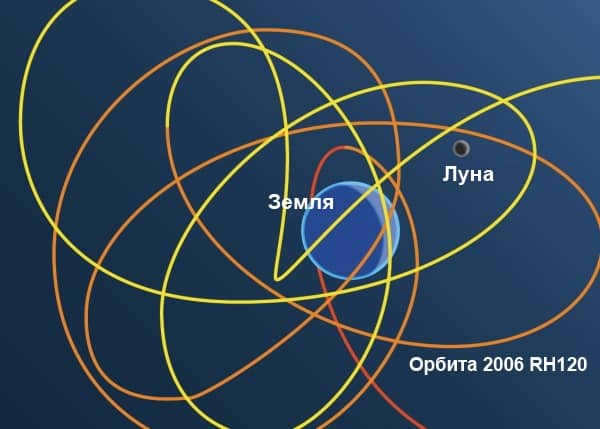
The path of asteroid 2006 RH120 in space
The atmosphere contains helium, neon, and argon. Helium and neon are formed by the solar wind, while argon is produced through the decay of potassium. Additionally, there are indications of frozen water within the craters. The surface is classified into various types, including maria which are flat plains that early astronomers mistakenly identified as seas. There are also terrae, which are highland regions, as well as mountainous areas and craters.
A skilled tarot reader will provide answers to the following questions:
What does the future hold for you? How will your relationships unfold? What is the best decision to make?

There are a total of five asteroids orbiting the Earth. One of them is 2010 TK7, which is located at L4. Another asteroid, 2006 RH120, approaches the Earth-Moon system every 20 years. In addition to these natural satellites, there are 1,265 artificial satellites and a staggering 300,000 pieces of debris floating around in space.
Origin and Development
In the 18th century, scientists theorized that the Earth, along with the entire solar system, originated from a nebular cloud. This cloud consisted of gas, ice, and dust, and about 4.6 billion years ago, it formed a disk-like structure around a central point. Over time, the majority of the material collapsed inward and eventually became the Sun. The remaining particles coalesced to form the planets that make up our solar system.
The Earth, in its earliest form, emerged 4.54 billion years ago. Initially, it was in a molten state due to volcanic activity and frequent encounters with other celestial bodies. However, around 4-2.5 billion years ago, a solid crust developed, along with tectonic plates. The process of degassing and volcanic eruptions gave rise to the first atmosphere, while the arrival of ice on comets led to the formation of oceans.
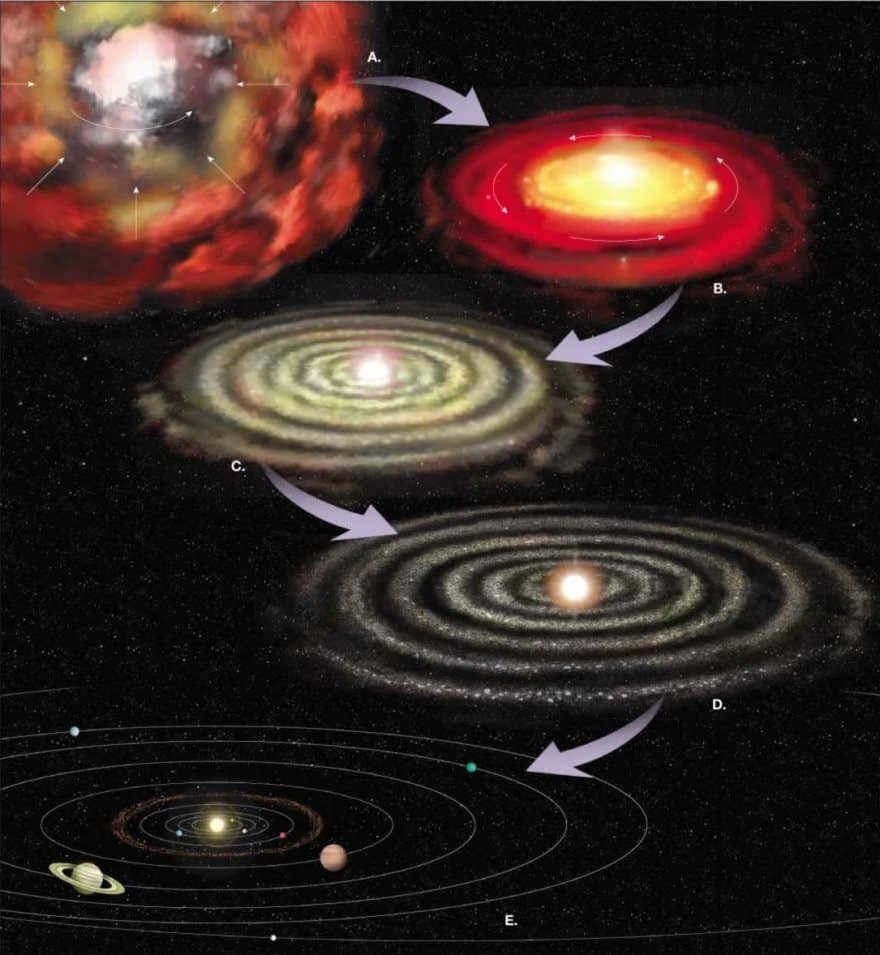
The development of the solar system
The outer layer did not remain frozen, causing continents to come together and separate. Around 750 million years ago, the initial supercontinent began to split. Pannotia was formed 600-540 million years ago, and the most recent one (Pangaea) separated 180 million years ago.
The current configuration took shape 40 million years ago and solidified 2.58 million years ago. The most recent ice age, which commenced 10,000 years ago, is currently ongoing.
The earliest signs of life on Earth are believed to have emerged 4 billion years ago (during the Archean eon). Self-replicating molecules emerged due to chemical reactions. Photosynthesis produced molecular oxygen, which, combined with ultraviolet rays, resulted in the formation of the first ozone layer.
Afterwards, a wide range of multicellular organisms emerged. Microbial life made its appearance around 3.7-3.48 billion years ago. Approximately 750-580 million years ago, glaciers covered a major part of the planet. It was during the Cambrian explosion when organisms began actively reproducing.
From that point onward (535 million years ago), there have been 5 significant extinction events in history. The most recent one (caused by a meteorite and resulting in the death of dinosaurs) happened 66 million years ago.
These extinct species were eventually replaced by new ones. A creature resembling an African ape began standing on its hind legs and freeing its forelimbs. This eventually led to the development of tool usage as the brain was stimulated. Later on, the cultivation of crops, socialization, and other mechanisms paved the way for the emergence of modern humans.
Factors for Habitability
When assessing the potential habitability of a planet, several factors come into play. Currently, Earth stands alone as the fortunate host of advanced life forms. So what are the requirements? Let’s begin with the primary criterion – the presence of liquid water. Additionally, the central star must emit enough light and heat to sustain an atmosphere. The location within the habitable zone (the distance between the planet and its star) is also a crucial factor.
We should take a moment to appreciate our extraordinary luck. Consider Venus, for instance. Despite its similar size to Earth, its close proximity to the Sun renders it a scorching hot place with acidic rain. On the other hand, Mars, positioned just behind us, is too cold and possesses a tenuous atmosphere.
Early efforts to understand the origin of Earth were rooted in religious beliefs and ancient legends. In various cultures, the planet was often personified as a mother and considered to be a divine being. As a result, many creation stories revolve around the concept of a mother giving birth to our planet.
The shape of the Earth has also captivated the curiosity of people throughout history. In ancient times, it was commonly believed that the Earth was flat, but different cultures added their own unique interpretations. For instance, in Mesopotamian culture, the Earth was envisioned as a flat disk floating in the middle of an ocean. The Mayans believed that four jaguars held up the heavens, while the Chinese imagined the Earth as a cube.


The Aztec deity Tonatzin, also known as “our mother,” symbolizes life on Earth.
As early as the 6th century B.C., scientists had already observed the Earth’s circular shape. Surprisingly, in the 3rd century BC, Eratosthenes managed to calculate the Earth’s circumference with an error rate of only 5-15%. The concept of a spherical Earth became widely accepted during the Roman Empire. Changes in the Earth’s surface were discussed as early as Aristotle’s time. Aristotle believed that these changes occurred too slowly for humans to perceive. This led to attempts to understand the age of the planet.
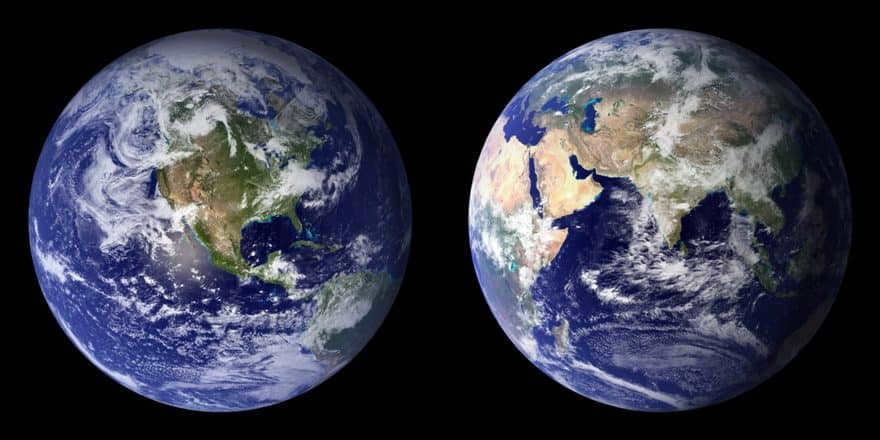
The image was generated using data collected between July and September 2001.
The field of geology has been the subject of extensive research throughout history. Pliny the Elder, a Roman scholar, compiled the first known catalog of minerals in the 1st century AD. In 11th century Persia, researchers focused on the study of Indian geology. Shen Guo, a Chinese naturalist, is credited with developing the theory of geomorphology and discovering marine fossils in unexpected locations.
The 16th century marked a significant expansion in our understanding and exploration of the Earth. Nicolaus Copernicus’ heliocentric model, which challenged the prevailing geocentric system, was a major breakthrough. Galileo Galilei’s invention of the telescope further revolutionized our understanding of the Earth and its place in the universe.
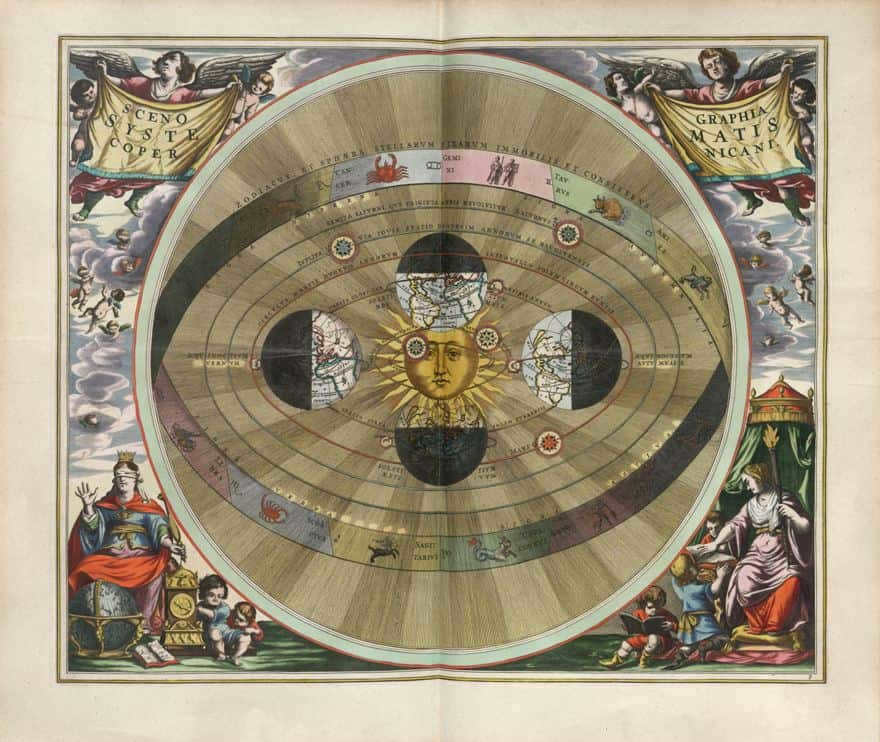
The Copernican system (1708 illustration)
During the 17th century, geology established itself as a prominent scientific field. The term was reportedly coined by Ulysses Aldwandi or Mikkel Eschholt. The discovery of fossils during this time sparked a significant dispute regarding the age of the Earth. Religious individuals insisted on a 6000-year timeline, as dictated by the Bible.
This controversy came to an end in 1785 when James Hutton proclaimed that the Earth was much older. He reached this conclusion by observing rock erosion and calculating the time required for such processes. In the 18th century, scientists divided into two factions. Some believed that rocks were formed through flooding, while others argued for fiery conditions. Hutton supported the latter perspective.
The Earth’s first geological maps emerged during the 19th century, with Charles Lyell’s publication of Principles of Geology in 1830. The advent of radiometric dating in the 20th century greatly simplified age calculations, revealing an estimated age of 2 billion years. However, the study of tectonic plates has since established a more contemporary estimation of 4.5 billion years.
The behavior of the Sun plays a crucial role in sustaining our lives. However, each star follows its own unique evolutionary path. In approximately 3.5 billion years, it is projected to expand in size by around 40%. This expansion will result in an increase in the amount of radiation emitted, potentially causing the oceans to evaporate. Consequently, plant life will cease to exist, leading to the extinction of all forms of life within a billion years. As a result, the average temperature will stabilize at a scorching 70°C.
After 5 billion years, the Sun will undergo a transformation and become a red giant, causing a shift in our orbit by approximately 1.7 astronomical units (a.u.).
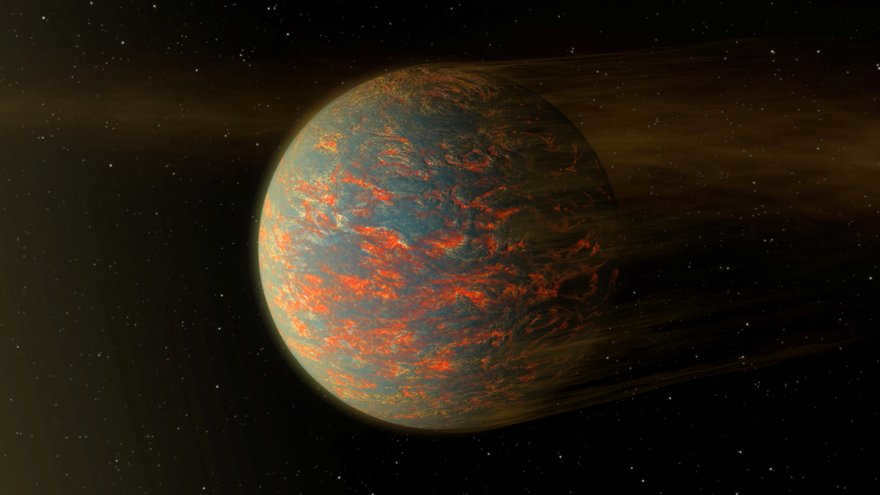
An artistic depiction of what the future holds for our planet
When you consider the entire history of the Earth, it becomes clear that humanity’s existence is just a brief moment in time. Nevertheless, Earth remains an essential world, a unique and cherished home. It is our hope that we will have the opportunity to colonize other planets beyond our solar system before the critical stages of solar development occur. Below, you can explore an interactive map of Earth’s surface. Furthermore, our website offers a multitude of stunning high-resolution photographs capturing the beauty of our planet and its places as seen from space. By utilizing online telescopes from the International Space Station (ISS) and satellites, you can even observe Earth in real-time, completely free of charge.
Map of the Surface
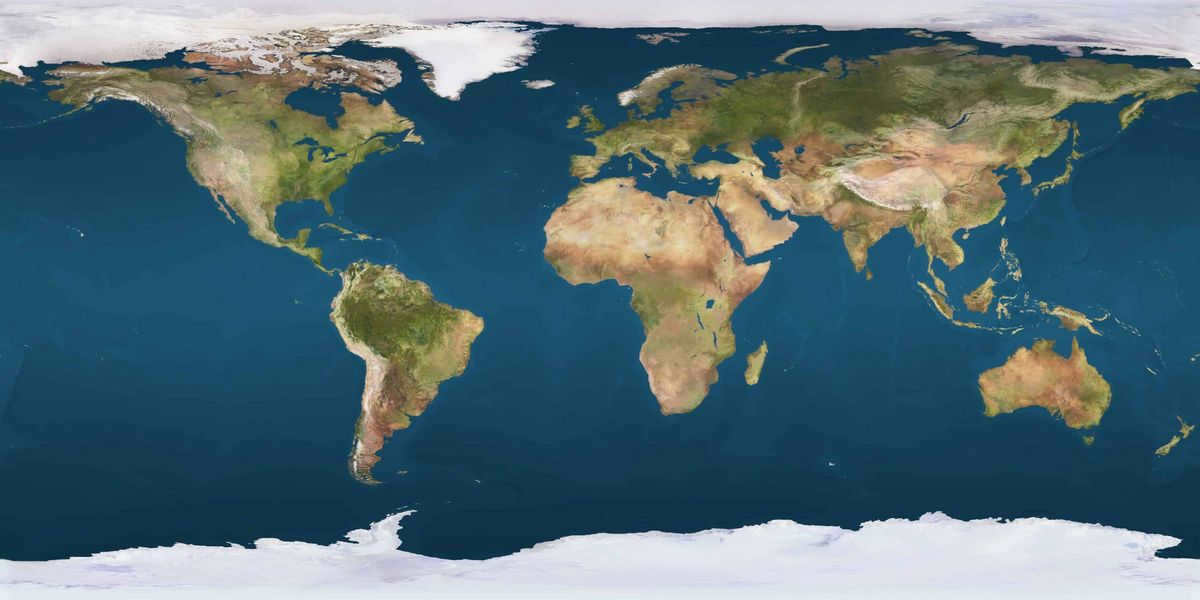
Click on the picture to see it in a larger size.
- How many satellites does Earth have?
- Is Earth spherical?
- Why is Earth round?
- Does Earth have rings?
- What is the size of Earth?
- Age of Earth;
- Mass of Earth;
- Gravity of Earth;
- What is the weight of Earth?
- Comparison of Earth’s weight;
- Size of Earth;
- Diameter of Earth;
- Circumference of Earth;
- Density of Earth;
- Earth’s magnetic field;
- Geomagnetic reversal.
Position and movement of Earth
- Earth, Sun, and Moon;
- Milankovitch cycles
- Solar day
- What is the duration of sunlight reaching Earth?
- Earth’s revolution around the Sun;
- What is the rotation of the Earth?
- What causes the Earth to rotate?
- What happens if the Earth stops rotating?
- Why is the Earth tilted?
- The magnetic north pole
- Earth’s orbit;
- Precession of the equinoxes
- Distance from the Earth to the Sun;
- Nearest star to Earth;
- Closest planet to Earth;
- Duration of a day on Earth;
- Winter Solstice
- How long is the Earth’s year;
- Earth’s rotational speed;
- Earth’s axis of rotation;
- Tilt of the Earth;
Earth
The study of the Earth’s orbit around the Sun in the vast solar system has captivated the attention of countless scientists. It serves as a valuable tool for understanding the planet’s elliptical trajectory, the cyclical shift of seasons, the transitions between autumn and spring equinoxes, as well as the enigmatic Lagrangian regions. This article delves deeper into the intricacies of this fascinating concept.
Characteristics of the Earth’s Orbit
In the 16th century, Nicholas Copernicus revolutionized our understanding of the solar system. He demonstrated that the Sun is at the center, with other celestial bodies, including the Earth, orbiting around it in a heliocentric system. This discovery brought special significance to the Earth’s orbit around the Sun.
Key features of the subject being studied
The Earth’s path around the Sun measures over 930 million kilometers. Our planet’s orbit around the star, known as the Sun, follows a specific pattern. The speed of this rotation is 108,000 kilometers per hour. The duration of one complete orbit is approximately 365.242199 solar days. Consequently, every three years, an additional day is added, resulting in a total of 366 days instead of 365.
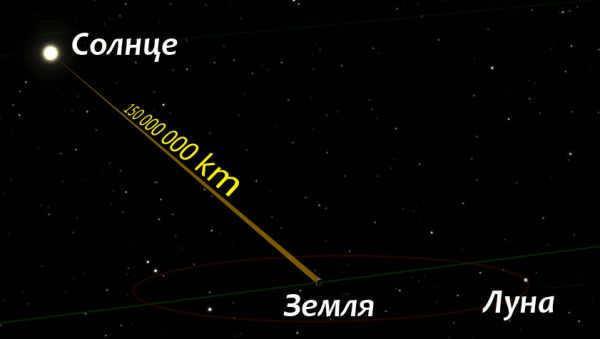
The Earth’s orbit around the Sun is not a fixed distance, but rather undergoes changes. At its closest point, known as perihelion, the distance between our planet and the Sun is 147,098,074 kilometers. On average, the distance is about 149.6 million kilometers. The farthest point, known as aphelion, is reached at a distance of 152,097,701 kilometers.
When considering the Earth’s orbit, it is important to note its unique characteristics, especially for those living in the northern hemisphere. The distance from the Sun does not directly determine the temperature. Instead, it is influenced by the tilt of the Earth’s axis, which causes the changing seasons.
The orbit of the Earth is not a perfect circle but rather an ellipse with a moderate elongation, as first explained by Johannes Kepler. Kepler discovered a pattern of planetary motion and conducted further studies, revealing that this motion is characterized by an elliptical shape.
During his research, Kepler also measured the orbits of Mars and Earth and noticed that they alternately accelerated and decelerated. These changes in velocity coincided with the positions of perihelion and aphelion. Consequently, the distance from the celestial body is determined by the orbital velocity.
In order to define the characteristics of the elliptical paths of planets, scientists from various countries have started employing the concept of eccentricity. In the present scenario, this value ranges from 0 to 1. When the parameter approaches 0, it indicates a circular orbit, whereas as it approaches 1, it signifies an elongated ellipse.
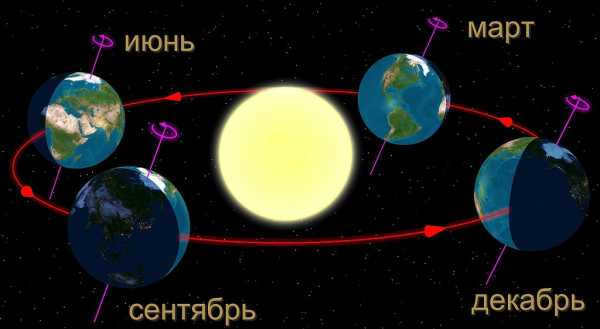
Seasons
Variations in the Seasons
The Earth’s path around the Sun, known as its orbit, gives rise to the four seasons. These seasons are a result of the Earth’s axial tilt, which is at an angle of 23.4 degrees. This axial tilt leads to astronomical phenomena such as the equinox and solstice, and is responsible for the occurrence of all four seasons throughout the year.
The immovability of the axis remains constant, thereby resulting in a different distribution of solar radiation. Specifically, when the northern hemisphere tilts away from the Sun, it experiences winter while the southern hemisphere has summer. This system undergoes a reversal after six months. The winter solstice occurs on December 21, while the summer solstice takes place in June. Additionally, the equinoxes occur on March 20 and September 23, marking the transition between spring and fall.
As previously mentioned, the orbit of the Earth around the Sun is referred to as its trajectory. It is distinguished by regions known as Lagrangian points. Specifically, there are five such points along our trajectory. These points experience a combined gravitational force that acts towards the center and scales accordingly. They are denoted as L1 to L5. They are established along a straight line formed by the Earth and the Sun. However, these points lack stability, meaning that a satellite sent there would experience displacement.





